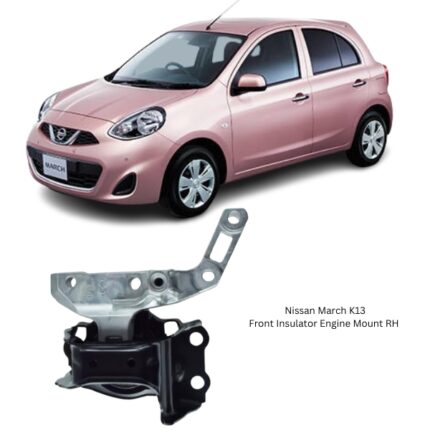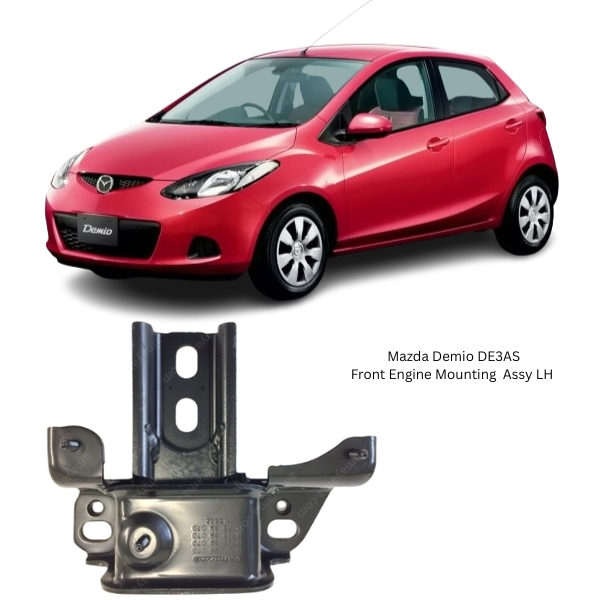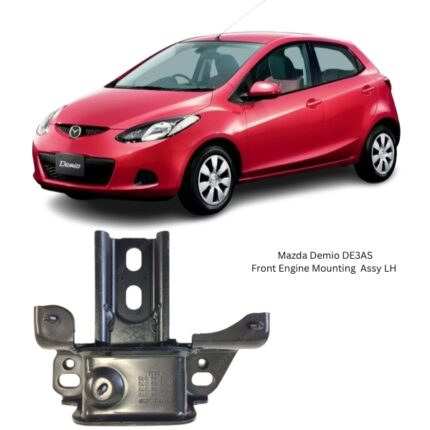Get Mazda Demio DE3AS Front Engine Mounting Assy LH D653-39-070A in Kenya
The Front Engine Mounting Assembly LH (Left-Hand Side) is a critical component of a vehicle’s powertrain support structure. Its primary role is to securely anchor the engine to the chassis while absorbing and isolating vibrations, shocks, and torque forces generated during engine operation and driving conditions. Positioned on the left-hand side of the engine bay (from the driver’s perspective), this mounting assembly plays a vital role in maintaining alignment, enhancing ride quality, and preventing damage to adjacent systems.
Made with high-strength materials and precision engineering, the front engine mounting assembly is designed to withstand constant mechanical stress, thermal variations, and long-term wear while ensuring quiet, smooth, and stable engine performance.
Purpose and Functionality
The engine generates substantial dynamic forces as it runs, accelerates, decelerates, and responds to road conditions. Without adequate support and damping, these forces would cause vibrations to transmit throughout the vehicle, affecting comfort and damaging components. The Front Engine Mounting Assembly LH serves multiple key functions:
-
Engine Stabilization
Holds the engine securely in place during all driving maneuvers, including acceleration, deceleration, and cornering. -
Vibration Isolation
Dampens engine vibrations to prevent them from transferring into the vehicle’s cabin, improving occupant comfort. -
Torque Control
Absorbs the rotational forces exerted by the engine, especially during gear changes or sudden throttle inputs. -
Maintaining Alignment
Ensures proper engine and drivetrain alignment, which is essential for maintaining transmission geometry and preventing premature wear. -
Protecting Adjacent Components
Prevents engine movement from damaging exhaust systems, hoses, electrical wiring, and sensors.
Construction and Design
The Front Engine Mounting Assy LH is engineered using a combination of high-grade materials and robust construction techniques. Its structure varies slightly based on design type—solid, hydraulic, or electronically controlled—but the core elements remain consistent:
Core Components:
-
Mounting Bracket/Base Plate
Typically made of cast aluminum, steel, or iron, this component bolts to the engine block and/or chassis and forms the structural base. -
Rubber or Polyurethane Isolator
A bonded elastomeric material that absorbs vibration and permits slight movement to reduce mechanical stress. The durometer (hardness) is tuned to balance damping and durability. -
Steel Sleeve or Core
Centrally located to house the through-bolt, allowing secure attachment while enabling flexibility and movement under load. -
Hydraulic Chamber (in fluid-filled mounts)
In hydraulic versions, the mount contains a viscous fluid chamber that actively dampens vibrations, especially at idle or low-speed conditions. -
Electronic Dampers (in active mounts)
Advanced mounts may include magnetic or solenoid-actuated mechanisms to adjust stiffness dynamically.
Performance Characteristics
The performance of the front engine mounting assembly directly affects driving quality and mechanical longevity. A high-quality mount offers:
-
Noise, Vibration & Harshness (NVH) Reduction
Dampens low- and high-frequency vibrations, ensuring a quieter and smoother ride. -
Durability under Thermal Cycling
Resists cracking and deformation from repeated heating and cooling cycles in the engine bay. -
Load-Bearing Strength
Supports the engine’s static and dynamic weight while maintaining rigidity. -
Torsional Flexibility
Allows limited movement to absorb torque without compromising stability.
Common Symptoms of a Worn or Faulty Engine Mount
Like any rubber or hydraulic component, engine mounts degrade over time due to exposure to heat, vibration, oil contamination, and mechanical fatigue. Key indicators of a failing left-hand front engine mount include:
-
Excessive Engine Movement
The engine rocks noticeably when starting, accelerating, or turning off. -
Clunking or Banging Sounds
A failed mount may allow metal-to-metal contact, especially during gear shifts or over bumps. -
Increased Cabin Vibrations
Passengers feel more vibration at idle or during acceleration. -
Misaligned Engine Position
Visual inspection may reveal that the engine is tilted or not centered. -
Wear on Adjacent Parts
Damage or stress marks on hoses, wiring harnesses, or brackets near the engine may indicate excessive movement.
Installation Overview
Replacing a front engine mount should be done with precision to avoid misalignment or undue stress on the engine and chassis. While procedures may vary based on vehicle design, the general steps include:
-
Secure the Vehicle
Ensure the vehicle is on a level surface and the engine is cool. -
Support the Engine
Use a floor jack with a block of wood or an engine support bar to hold the engine in place. -
Remove the Old Mount
Unbolt the mount from both the engine and the frame. Some mounts may require loosening adjacent components for access. -
Inspect Mounting Surfaces
Clean and inspect mounting brackets and bolts for corrosion or damage. -
Install the New Mount
Align the new mount correctly, insert bolts, and torque them to manufacturer specifications. -
Lower the Engine Carefully
Remove the support and allow the engine to rest securely on the new mount. -
Test Drive
After installation, check for any unusual noises or vibrations and confirm engine alignment.
Maintenance and Inspection
Engine mounts are generally maintenance-free but should be inspected periodically, especially during:
-
Oil change services
-
Suspension or transmission repairs
-
Unusual vibration complaints
-
Routine safety inspections
Ensure that the mount rubber is free from cracks, separation, or contamination. Hydraulic mounts should show no signs of fluid leakage.
Advantages of Replacing a Worn LH Engine Mount
Replacing a worn front engine mount delivers immediate improvements in several areas:
-
Enhanced Ride Quality
Reduces vibrations transmitted into the cabin for smoother operation. -
Restored Engine Stability
Eliminates clunks and reduces rocking under throttle. -
Protects Driveline Components
Prevents damage to axles, transmission mounts, and exhaust parts. -
Improves Handling and Braking
Reduces weight transfer and maintains alignment under load. -
Increases Part Longevity
Prevents abnormal stress on engine brackets, hoses, and electronics.
Follow us on Facebook for more parts.





Reviews
Clear filtersThere are no reviews yet.